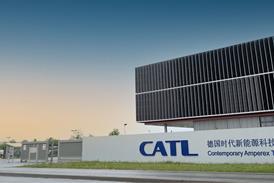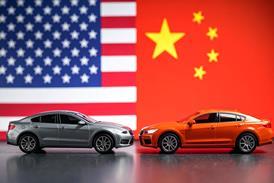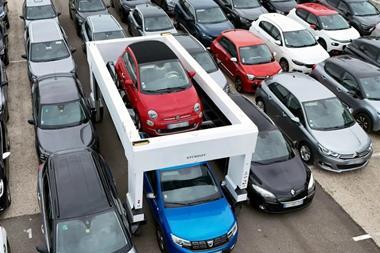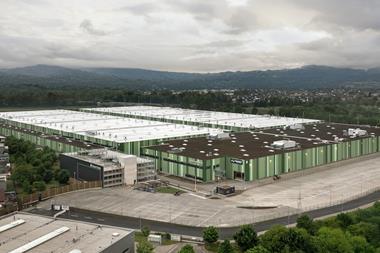This year’s Finished Vehicle Logistics Import Export summit in Baltimore revealed an industry embracing the latest digital technology to deal with some familiar challenges around port capacity, infrastructure and security, but facing changing dynamics in the movement of vehicles around North America, not least the renegotiation of the Nafta trade agreement. Marcus Williams reports

The North American finished vehicle sector remains largely in robust health. Vehicle sales remain strong in the US, despite a levelling off after seven years of consecutive growth, and are growing in Mexico. Import and export activity, both within the region and with international markets, looks dynamic over the next five years and assembly within the region, Canada aside, is set to increase up to 2023.
Delegates at this year’s Finished Vehicle Logistics Import Export summit, held in Baltimore last week, were keen to explore this resilience and look at the way advances in digital technology – notably in the vehicle itself – are providing opportunities to make further gains in a more efficient outbound process.
Along with growth in assembly and greater activity in and out of North American ports, however, there are concerns about capacity and congestion, as infrastructure struggles to cope with growing numbers, increasing dwell times and underinvestment.
Velocity of throughput remains key to managing this. Mark Boucher, director of vehicle logistics at Volkswagen Group of America (VWoA), said: “When you look at any of your technology and the opportunities associated [with that], you look at velocity. Velocity drives your footprint; it drives your car requirement; it basically drives all your brick and mortar.”
Investment in port infrastructure and the growth of private sector financing to support public expenditure, along with other supporting measures, were flagged as priorities and, as in other years, the question of security in northbound flows continues to be an issue.
There are also big questions over what the renegotiation of the North American Free Trade Agreement (Nafta) – which starts officially August 16th – will mean for the car industry in the region. A number of OEMs have switched plans around since the beginning of the year, though there now seems less of a risk that a 20% tariff on Mexican vehicle imports will actually be applied.[in_this_story align="right" border="yes"]
Smart cars in the system[sta_anchor id="1"]One of the most important areas of emerging technology that will influence the development of finished vehicle logistics over the next few years is the car itself. The digital vehicle is set to transform the way vehicles are shipped and delivered as companies exploit telematics and the burgeoning autonomy built into vehicles.
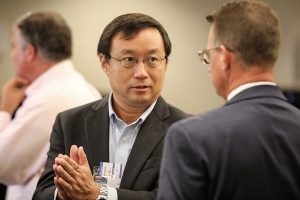 Tianbing Qian, senior vice-president and chief information officer at Ports America
Tianbing Qian, senior vice-president and chief information officer at Ports AmericaTianbing Qian, senior vice-president and chief information officer at Ports America, said that the vehicle was a digital hub that could identify where it was and how to park itself, give status updates on its components and avoid accidents autonomously. However, such technology is not being used enough in the delivery process, he suggested.
“That is the future, if we do more collaboration and find how to exploit the digital capability of the smart vehicle,” said Qian. “It will make a dramatic improvement on the safety and quality, and cycle time, as well as operational performance. We need to use those digital features for logistics.”
That view was shared by many attendees at the summit, with half of them agreeing in a poll that being able to leverage the digital vehicle had the most potential to improve ro-ro port operations. The same number also suggested that the main advances in visibility and tracking in the outbound delivery process would come from telematics and 'connected car' technology.
It was a point backed up by a number of carmakers at the event. GM, for one, already has its OnStar technology, which provides remote diagnostics on the condition of the vehicle along with a range of other communication services. Alrick Duncan, intercontinental and port operations supervisor, said the next step was to get that technology into the import and export part of the business and use it to track the right vehicles.
“GM has the technology in the vehicle and I think we would look more to the port processors to be able to communicate, to take that data and bring it together so we as the customer could track the vehicles and understand what is going on,” said Duncan.
Boucher at VWoA said that connected car technology was exciting because it would fully connect the inventory and bring speed to market through greater operational efficiencies. Flashing updates to vehicles at ports in the US could be done from Germany, rather being a lengthy manual process requiring a lot of labour. He agreed with Duncan on the next steps in how to use that technology.
“We work on our proprietary technology and internal processes, and improve that through the connected car,” said Boucher. “Then the next step is to go to port processors and transportation partners, and maybe other OEMs.”
 Chuck Kendig, assistant vice-president – logistics, sales and production planning at American Honda
Chuck Kendig, assistant vice-president – logistics, sales and production planning at American HondaChuck Kendig, assistant vice-president – logistics, sales and production planning at American Honda, said that a more immediate requirement was to establish 25.9GHz spectrum sharing to connect vehicles on the road and be able to identify where they were in the marshalling yard and in the pipeline to the dealer. However, that needed approval from the Federal Communications Commission (FCC) and Kendig said there had been no movement since discussions began in 2016.
Global connectivity[sta_anchor id="2"]The Automotive Industry Action Group (AIAG), meanwhile, is working on a number of initiatives to improve visibility in the supply chain by exploiting this in-car technology and is launching a Connected Car Working Group for logistics this September.
Trish Zarik, finished vehicle consultant at the organisation, used the summit to issue “a call to action” aimed at OEMs, engineers, IT and supply chain managers.
“The point in the US now is to identify specifics in the vehicle and how they can improve supply chain management,” she said. “How do we make moving a connected vehicle better for everyone?”
Zarik said it was important to work together to define what it was the industry needed and establish guidelines to improve processes. “We need to work together cross-functionally under an organisation that offers that service,” she said.
[related_topics align="left" border="yes"]The AIAG has been working with the Association of European Vehicle Logistics (ECG) on a number of initiatives aimed at establishing global standards in finished vehicle processes. Chris Kenmore, CEO of yard management software specialist Vehnet, outlined some of the things being done at the ECG to gain transparency in the outbound sector by establishing telematics standards and exploiting other data from the digital car to make deliveries more efficient. The association is working with OEMs to develop standards in handling messaging from vehicles.
“We are trying to create a standard for communications to and from the vehicles,” confirmed Kenmore. “The OEMs are not keen with LSPs having direct contact with the vehicle. What they want is for the vehicle to communicate with them via a neutral server. We need to create a standardised message. All OEMs will communicate with that.”
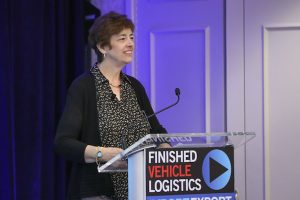 Trish Zarik, finished vehicle consultant, AIAG
Trish Zarik, finished vehicle consultant, AIAGThe EU also has a mandate for ‘e-call’ features in all vehicles by 2018, similar to the Onstar system, in which cars are connected and able to send distress messages if they are involved in an accident. That implies vehicles have a communication device for tracking and location, something that can be exploited by those involved in finished vehicle delivery. The ECG also wants to establish two-way communication, for example to be able to tell the vehicle where to park or to go to its workshop for processing.
However, as Kenmore pointed out, this requires data from the OEMs, which brings up questions of proprietary access. Marty Colbeck, director of East Coast Sales at Auto Warehousing Company, said manufacturers with their own proprietary systems had so far been unwilling to change or share that data in any kind of a format that could be used by the industry – and asked whether they were now ready to change.
Charles Franklin, manager export logistics – export sales division at American Honda, said that depended on whether the data a carmaker shared was going to help it sell cars, which was the bottom line.
“You can't just say ‘give me your data’. You have to give me a defined process about what you are going to do that uses it,” said Franklin.
He went on to outline an algorithm used by the airline industry that helped transport providers evaluate if they were profitable with the contracts they had, in the process creating a unified database of information that also helped the buyer. Franklin then applied this model to a potential standardised RFP (request for proposal) platform for the automotive industry.
“If you are doing a proposal for a trucking company, people can put data into [an algorithm] and transport providers could see the data, which makes it much easier for them to respond and to manage it, so everyone gets a deal and at the same time you are creating a database that can be shared,” explained Franklin. “[It could tell you that] next year the OEMs will be making this many cars and shipping them through these ports, and you can manage how you support that. There are ways to do it, but if you say just ‘give me your data’ it is not going to happen.”
Alternative powertrains[sta_anchor id="3"]One other area where the latest vehicle technology promises to bring benefit to the outbound delivery process is through the growth of alternatively-fuelled vehicles, though on this count the US could be heading in a different direction to the rest of the world.
Currently, electric, hybrid and fuel cell cars make up just more than 4% of the global car market and PwC forecasts that will rise to 11% by 2023, mainly driven by regulation rather than mainstream consumer demand.
Europe is leading the charge and is expected to account for between 40-50% of the market in the next 15-20 years, according to PwC’s automotive director and mobility leader, Brandon Mason, but large growth markets such as India and China are increasing their regulatory mandates on alternative propulsion vehicles.
Almost half of the delegates at Baltimore this year (46%) thought that within the next 10 years, as many as a quarter of all vehicles handled within the US ports would be electric-driven, and the carmakers present said they were making preparations.
GM’s Alrick Duncan said his company was building on the segment lead its Bolt EV had and looking ahead to handle greater volumes of electric vehicles at the ports. That included figuring out what resources to put in place to maintain battery power in the vehicles.
“We are shipping more of those vehicles to Europe and Asia,” said Duncan. “But as the market continues to change, you will see more electric vehicles coming onto the platforms in different regions.”
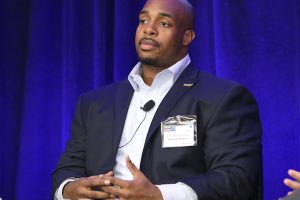 Alrick Duncan, intercontinental and port operations supervisor, GM
Alrick Duncan, intercontinental and port operations supervisor, GMIn the US, low fuel prices and a preference for light trucks means that alternative-fuel cars currently make up only 3% of the market (compared to 11% in Europe) and the Trump administration is considering either freezing or rolling back current targets.
“Just a few years ago, the world seemed to be aligned around increasing emission standards and the fuel-efficiency of vehicles,” said Mason. “Now the US is headed in an opposite direction.”
That situation is unlikely to change without either a big drop in the costs of alternative propulsion technologies or an extreme spike in gasoline prices – neither of which seem likely at the moment.
Nevertheless, like GM, other carmakers are looking ahead. Chuck Kendig pointed out that Honda foresaw two-thirds of the vehicles it sold by 2030 being electric.
“We don't have issues right now in moving the ones we have through the ports – they have enough battery power – but if they had to dwell for a long time it would be different,” he said.
Whether exports will account for a large portion of the electric cars being handled at the ports in 10 years’ time remains to be seen, but carmakers supplying EVs to global markets will certainly face difficulties, given the divergence in the adoption of regulatory standards across the world.
While US consumers may not be choosing alternatively-fuelled cars in any great numbers in the US, there is at least evidence that carmakers are interested in adopting the technology for moving their products to market.
Honda's Chuck Kendig said the carmaker was moving vehicles from its Lincoln plant to the rail facility at Talledega by transporters fuelled by compressed natural gas (CNG), for instance. Its outbound finished vehicle carrier, Virginia Transportation Corporation, is now using a fleet of 30 CNG-fuelled transporters. The carmaker is shipping 1,200-1,400 vehicles a day from the plant to Talladega for movement by rail to the dealer network.
Honda also opened a CNG fuelling station adjacent to its Marysville assembly plant in Ohio in 2015 to promote the use of natural gas-powered trucks for the delivery of parts in the region.
“If we see the potential for LNG [liquefied natural gas]/CNG vehicles in a milkrun, where the infrastructure exists, we will look to adapt to it and sign a longer contract with a partner who will do that for us,” said Kendig.
Kendig also pointed to Honda shipping vehicles globally on LNG-powered ocean vessels managed by K Line, something VW is also doing with its recent charter of two LNG-powered car-carrying vessels from Siem Car Carriers for its Europe-North America route from next year.
Production to remain strong[sta_anchor id="4"]Alternative-drive vehicles aside, US domestic light vehicle sales are forecast to take a marginal dip over the next couple of years, with vehicle inventory and incentive levels currently the highest they’ve been in about a decade. However, finished vehicle logistics looks set to remain healthy, including assembly, port and terminal-related vehicle handling.
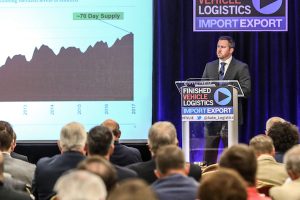 Brandon Mason, automotive director and mobility leader, PwC
Brandon Mason, automotive director and mobility leader, PwCAccording to PwC, US light vehicle sales are likely to drop to 16.8m units this year from a record 17.5m in 2016 – the first decline since 2009. Even so, industry experts consider this well above what it takes for the US automotive industry to remain profitable. What is more, assembly in the country is set to increase, alongside Mexico, with each accounting for total annual increases of around 1m units over the next five years.
The US still remains a significant centre for imports, which numbered 8.2m units last year, around half of them from outside North America, according to Mason. Mexico accounted for 2.2m of those neighbouring imports, a 50% increase on five years ago. The bulk of non-North American imports came from Japan, Germany and South Korea. While Mason predicted import numbers would remain high, he suggested those from outside North America could decline in coming years.
“We are going to continue to be a net importer of vehicles,” said Mason. “What we expect to see over the next three to five years is further consolidation or import substitution from the Asian carmakers.”
Mason predicted that the shift to US and Mexican plants, together with some increases in exports, would keep vehicle production strong in North America even though new light vehicle sales would remain relatively stagnant.
Assembly in the US is set to rise to 12.8m units by 2022, suggested Mason, compared to 11.8m in 2016 and 11.5m forecasted for this year. Mexico will also increase assembly to 4.5m by 2022, from 3.5m units in 2016 and an expected 4m this year; while Canada is expected to decline from 2.4m to 1.9m as carmakers focus on the US and Mexico.
Exports from the US could also be on the rise, particularly from German OEMs including BMW and Mercedes-Benz, who could drive volume out of US east coast ports to meet growing global demand for their SUV and compact SUV products, said Mason.
“That will be a good volume and amounts to 19m units [of North American production] by 2023 with pretty strong utilisation at the facilities – and that should weather any moderate downturn we see in the sales cycles,” he commented.
While growth may be stronger for the continent’s factories and internal flows, ports handling both exports and imports across North America will probably continue to see strong volumes, including increasingly growing ocean trade from Mexico to the US. Ports and terminals are also likely to face pressure on their facilities and assets.
Such pressures are already rising again today, in part because of the market cooling. Inventory levels are up to 4.2m units, an average of around 70 days, according to PwC – the highest since 2005 and about 10 days more than is considered healthy.
All too often, the ports take on a growing burden of storage requirements for some brands, something that is causing congestion and hitting dwell times. Higher inventory risks increasing sales incentives and could lead to problems down the line unless greater discipline is taken by manufacturers to match production with sales, warned Mason.
Trade with Mexico[sta_anchor id="5"]Complicating the outlook, of course, are ongoing questions about continued trade within North America between Mexico and its neighbours to the north, after the election of Donald Trump who has criticised Nafta and especially Mexican trade in harsh terms and threatened to impose a border tax. Renegotiation of the 23-year old Nafta agreement is about to get underway.
Mason acknowledged the uncertainty and said carmakers were looking at the flexibility in the capacity they had across North American operations in preparation.
For example, as has been reported, a number of carmakers have changed some of their production plans for Mexico, though they tend to deny such moves are in response to Trump’s threats, instead attributed them to market conditions. Ford, for example, cancelled a new plant and later production of the new Focus in Mexico. It now plans to import the new Focus from China rather than building it in the US.
More recently, Toyota has announced that it will build a new plant with Mazda in a yet to be determined location in the US; meanwhile, its planned factory in Guanajuato, Mexico, which is currently under construction, will now produce the Tacoma pickup truck, rather than the Corolla, as initially envisaged, something that will delay the start of production there.
However, some of the fears over threats to Nafta arrangements seemed to have subsided somewhat among those attending the conference. Speaking at the opening session of the summit in Baltimore, the president and chief executive officer of the US-Mexico Chamber of Commerce, Al Zapanta – who played a key role in drafting the Nafta agreement in the 1980s – suggested that there would be no damaging changes to the agreement in terms of either tariffs or complex rules of origin rules.
Repeating testimony that he made in July to the Office of the US Trade Representative, which is responsible for the renegotiations, Zapanta highlighted the strength of the agreement and the benefits the world’s largest trade region had brought since its inception in 1994, and maintained that renegotiating the Nafta agreement had the potential to benefit everyone involved in it, including in terms of automotive trade and security.
“There is a key phrase that I brought to the testimony and that is ‘a fair and balanced trade agreement’,” said Zapanta. “Because of 24 years of Nafta, there have been pluses and minuses, but now is an opportunity to look at the trade agreement and figure out how we can make it fair for all sides, and at the same time balance it so that we have the ability to rise together.”
However, he went on to say, there was now a heightened focus on international trade, immigration and cyber- and physical security.
 Al Zapanta, president and CEO of the US-Mexico Chamber of Commerce
Al Zapanta, president and CEO of the US-Mexico Chamber of CommerceZapanta said the industry had to consider the notion of North America in the context of today’s challenges in the region, “including security, global governance, and the quest for energy independence”.
On the question of security and the much-discussed wall proposed between the US and Mexico, Zapanta said he saw this as more of a ‘smart border’ that would leverage technology. “Nobody ever said that a wall has to be bricks and mortar,” he commented. Trump’s statements on this have been somewhat inconsistent, though he did say last month that the wall would be “see-through”.
Zapanta said that in this day and age and for the future, a wall would be built on IT and innovation. “We see smart cities and smart communities. Well guess what? We should be able to do the same on our borders,” he said.
Delegates at the event seemed generally to share Zapanta’s optimism over the outcome of the Nafta negotiations. The majority of delegates (64%) canvassed on the day were either ‘somewhat optimistic’ or ‘very optimistic’ about just how the renegotiations would impact on their business.
Security strategies in Mexico[sta_anchor id="6"]Security is a key concern in terms of the movement by rail of vehicles to the border with the US, as vandalism, theft and drug smuggling are something rail companies shipping vehicles regularly have to deal with. That is one reason why the ratio of imports moving by short-sea is now increasing compared to rail, according to speakers and delegates at the conference (something 63% of delegates voting on the question confirmed).
Alrick Duncan confirmed that vandalism on the rail network was why GM wanted the option of short-sea. “Our short-sea options have grown. We just recently started shipping into Grays Harbor by short-sea, which would have gone by rail, and the same thing to Aransas [Texas]. We normally would have gone by rail but we pulled those units out and actually started going by short-sea. Having the option is definitely great for GM.”
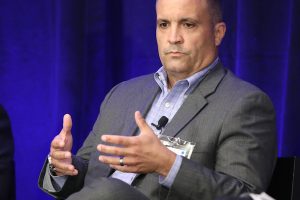 Mark Boucher, director of vehicle logistics at Volkswagen Group of America
Mark Boucher, director of vehicle logistics at Volkswagen Group of AmericaIt is a similar story at VWoA. “We have had a hybrid strategy for years serving the eastern US by [ocean] vessel out of Veracruz and western points by rail, but we have struggled, like most of the OEMs, with vandalism and damage on Mexican rail,” said Mark Boucher. “It continues to be a problem. I will say that it has improved, but it is still not nearly at the standard, so we are looking for opportunities for short-sea.”
One of the consequences, Boucher added, was that everyone was doing the same and that there was only a finite amount of space, particularly on the eastern side of Mexico. That said, he said it was still a safer route to get the products to market.
Others at the conference also raised the problem of vandalism and described various measures to deal with it. One notable success was provided by Franklin of American Honda, who said the company had seen vandalism to 3,500 vehicles a year outbound from Celaya for export to markets outside the Nafta region. The company switched to truck and has since had seven months of largely damage-free transport.
Chuck Kendig at American Honda had another example of how vandalism had been dealt with, this time for vehicles moving to the US and Canada by rail. The company was losing batteries along with the more expensive harnesses attached to them.
“The battery is $100, the wire harness that is attached and gets destroyed is about $1,000 between parts and labour,” explained Kendig. “So we decided that once the car was loaded on rail we would take the terminal heads off and strap them away from the battery so if the thieves did get on board, they just got the battery.”
In another colourful example related by Zapanta, Union Pacific found itself facing a $500,000 fine when customs at the border discovered a whole box car full of narcotics that had been added to one of its trains heading north.
Congestion and dwell [sta_anchor id="7"]The greater shift to short-sea adds to the problem of congestion at the ports, however. Kurt Nagle, president and CEO of the American Association of Port Authorities (AAPA), highlighted the importance of private sector funding and said the message to Washington, DC was that ports and their private sector partners were making significant investment to bring ports up to scratch.
Referring to a survey of members the AAPA had recently conducted, Nagle said public ports and private sector partners planned to invest $155 billion in port infrastructure over the next five years. However, he said that there was a shortfall in areas covered by federal jurisdiction, namely the landside and waterside connections, and that could amount to $43 billion between now and 2040, if the situation did not change.
“On the waterside we have several challenges and the most basic at the moment is that the US Army Corps of Engineers [which maintains infrastructure in the US] is not being provided with adequate resources to even enable them to maintain federal navigation channels at the depths and widths that they are currently authorised and need to be,” said Nagle. “That impacts the flow of vessels and car carriers, and how large those vessels can be and how much they can load.”
On the landside, meanwhile, another survey carried out by the AAPA revealed that one out of three ports in America sees a need for at least $100m to be invested over the next 10 years in first- and last-mile connections, including in interstate highways and the mainland railway.
Taken together, better landside connections and upgrades to the navigation channels into the ports were “absolutely critical”, said Nagle.
 Kurt Nagle, president and CEO of the AAPA
Kurt Nagle, president and CEO of the AAPA“In many cases, the most significant bottlenecks and capacity limits, the aspects affecting efficiency as well as local communities, are impacted at the connection level,” he said. “Whether landside highway connections or for the navigation channels, those connections are critical.”
According to Bill Kerrigan, vice-president of logistics in the automotive division of terminal operator SSA Marine, there are no properly connected ro-ro ports. This is despite the fact that US ports imported 4.92m passenger vehicles last year, including 650,000 from Mexico. There is also likely to be more traffic from other markets.
“Sales may decrease but regardless [of that], we are going to see increases on short-sea from Mexico,” said Kerrigan. “We are getting enquiries about cargo from south-east Asia. Ford have announced they are going to build a product in China and they won’t be the last to do that. I think we are going to see increasing pressure on the ports that are handling ro-ro now.”
At the same time those US ports are exporting 1.1m units and also handling a lot more construction equipment and project cargo, more of which is now being carried on pure car and truck carriers (PCTCs) and all of which is vying for space at vehicle handling terminals at the ports.
Space is at a premium, as there is no more port land left to develop in the areas in the south-east and near the population centres that OEMs and logistics providers are targeting.
Ports have increasingly become used as storage facilities, however, with cars on site for anything between 75 and 125 days, when they should be used purely for throughput, said Kerrigan. All this is leading to congestion and increased dwell time, which is a problem for everyone involved.
The critical impact this has on available operating space at the ports was put into perspective when Kerrigan explained that at its facility at the congested Mexican port of Veracruz, SSA Marine would be able to handle volumes for another five years without expansion if it could eliminate a day and a half of dwell time.
“We have to work with our providers, including the railroads and our partners in this, to figure out a better way to handle just-in-time delivery to the port for export, and vice-versa for imports,” he said.
Effective communication[sta_anchor id="8"]Carmakers have seen improvements in Mexico through establishing better communication with their rail and ocean service providers.
Honda’s Chuck Kendig said trains with US-bound vehicles wouldn’t be sent to the Mexican ports it used unless it had a guarantee that they were on schedule to meet the ship, because there was little room at the ports and any train delay risked vandalism.
“That communication has been much more effective,” said Kendig. “Basically, it is a block and tackle operation and that is a big help to keep non-stop trains running. We have good visibility with the ships coming in and good communication with our partners MOL and K Line.”
Proactive real-time tracking of volumes by rail to ocean vessels is also one area of the supply chain that VW is working on, according to Mark Boucher – something he said was a big help for port landing and getting trains to load vehicles at the right time.
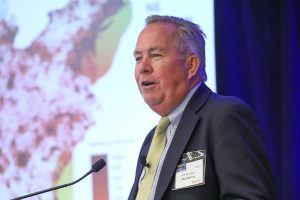 Bill Kerrigan, vice-president, logistics, auto division, SSA Marine
Bill Kerrigan, vice-president, logistics, auto division, SSA MarineWhile building multi-storey facilities on existing ground is not an option because there is not enough money in the system, said Kerrigan, there are still opportunities to be found by taking a lead from the container industry and look more into inland ports.
“They are for the most part served by rail, so we are not looking at expensive truck rates or rehandling costs,” said Kerrigan. “And they are close to the market.”
He pointed to the example that Glovis America has provided in repurposing the former GM plant in Shreveport, which is being used to handle imported Kia volumes from Mexico for onward distribution to central and western US regions.
Without the port property, where are we going to go?” asked Kerrigan. “There happens to be a lot idle plants in the Northeast and Midwest that could be used as distribution points.”
Another factor that will affect throughput over the next five to 10 years, according to Kerrigan, is anticipated consolidation in the car carrier sector.
“That is going to have a real impact on ports, because fewer carriers are going to want to go to fewer ports,” he said. “We are going to have to figure out a way to increase throughput.”
Kerrigan pointed to a number of other ways this could be achieved, including more multi-OEM processing facilities, a return to vessel-sharing agreements and the use of 24/7 gates at processing facilities.
Smart infrastructure[sta_anchor id="9"]Ports also need to be brought up to date for handling smarter vehicles.
Mason of PwC said there was a need to invest heavily in infrastructure, beyond that required to bring US road, bridge and port infrastructure back up to par. “Significant investment is needed just to fix our roads and bridges, but [beyond that we need] to invest to make it adaptable to smart technology – to have sensors and signs that can be easily seen by these autonomous vehicles, that talk to one another,” he said. “There is a lot of room to grow here but it is hard to come up with the dollars.”
Travis Black, StrongPorts community planner at the US Department of Transport's (DoT) Maritime Administration admitted that his department had limited resources and was looking to bring in the private sector to establish partnerships. However, one of the funding programmes it does have that benefits ports to the tune of an annual $60m is the Advanced Transportation and Congestion Management Technologies Deployment (ATCMTD) Program. This is available specifically for port authorities to improve throughput and in June the DoT completed the second round of funding proposals, which it is now evaluating.
Black also talked about the DoT's federal Intelligent Transportation Systems (ITS) programme, which focuses on vehicle-to-vehicle and vehicle-to-infrastructure communications through the application of advanced wireless technologies to change surface transport systems for the better and make the application of new technology safe for the public.
“In the movement of vehicles, one of the things we are really interested in is connected vehicles,” said Black. “There are so many opportunities out there that we are trying to take and base an assessment on,” he said. “We are looking at where the technologies are right now and how to expand the utilisation in different ports, and make it easier to implement it in places where it is not happening.”
Black explained that through the ITS Joint Project Office, the DoT was aiming to establish a baseline to guide its research in the port maritime area.
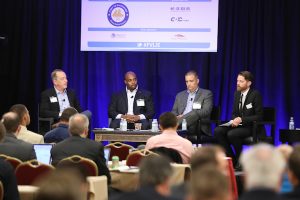 Carmakers agreed that connectivity had the potential to completely change what they did
Carmakers agreed that connectivity had the potential to completely change what they did“We have currently identified truck staging as a need and we will be doing pilots over the next few years to test the application in the ports,” he said. “We are also working with the American Association of Port Authorities (AAPA) to develop a module and toolkit that will explain ITS and help with its implementation.”
Embracing change[sta_anchor id="10"]Carmakers, too, are assessing the future, and looking ahead at connectivity and what new vehicle architectures mean for the movement of their goods across a changing network over the next five to 10 years.
“The connected car and the blockchain, where we are all speaking to each other, has tremendous potential to change completely what we do,” said VWoA’s Mark Boucher. “I would say that those of us that are out on the front of that technology and that connected relationship are going to be the ones that stick around.”
It is all about embracing change, according to Chuck Kendig, as major shifts in vehicle use and purchasing transform the finished vehicle industry.
“We will see increased frequency and amplitude of major shifts with the Amazon effect,” said Kendig. “Tesla has busted the franchised dealer network and, if that continues, how people buy cars or use them is going to change.”
Those shifts will affect how vehicles are supplied, as will the cost of the latest technology put into the car to connect it to a smarter infrastructure and a digital world, either by mandate or customer preference.
At the end of the day, rises in R&D expenditure and material and labour costs will increase pressure on pricing, said Kendig – and that means a squeeze on operating costs.
He encouraged logistics service providers to work hard on innovating in the current business model and looking for what the new one might look like.
“Bring innovation – and slap us around if we are not listening,” he said.
The Finished Vehicle Logistics Import Export Conference is part of the global Automotive Logistics series of conferences.
The next conference in the series is Automotive Logistics Global, the signature event in North America, on September 19th-21st in Detroit.
















